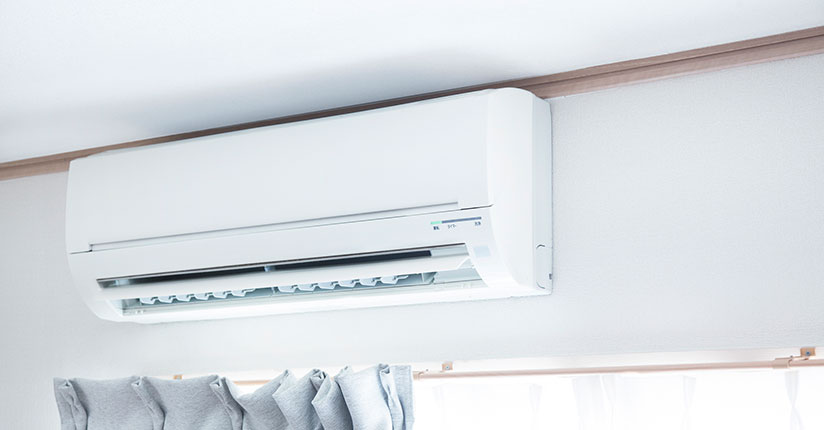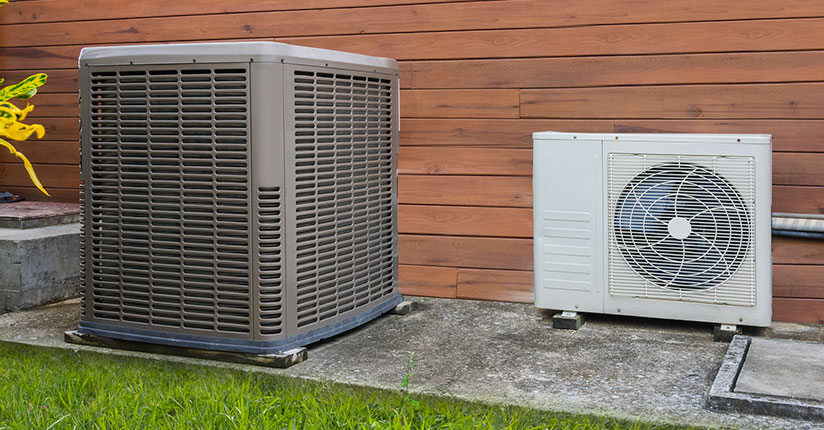Using and Maintaining Your Heat Pump

If you’ve recently installed a heat pump, or have moved into a house with a heat pump, the following information will help you learn how a heat pump works and how to properly maintain it to keep it as efficient as possible.
How They Work
Heat pumps act much like a refrigerator in reverse, transferring heat from one place to another. While a fridge transfers heat from inside the fridge to outside (to cool the inside space), a heat pump uses a small amount of energy to move heat that exists outside the house, to the inside. Even on cold days there is heat available from the outside, which can be used to heat your home. This means that instead of generating heat like electric baseboards, they can use electricity to give more heat for less cost. The two components of a heat pump – an inside unit and an outside unit – work together as a system to transfer and distribute the heat to the home.
Types of Heat Pumps
Heat pumps need a source of heat, which is traditionally the outside air, the ground, or a large body of water. Systems that transfer heat from the outside air are called air source heat pumps and systems that transfer heat from the ground or water are called geothermal heat pumps. Most heat pumps installed in New Brunswick today are air source, but both types have their pros and cons
There are two main types of air-source heat pumps: ducted systems and ductless or “mini-split” systems.

Ducted systems use forced-air ducting to distribute heating and cooling whereas mini-splits do not require a forced-air system.
Ductless mini-split systems are generally more affordable than ducted systems and are currently the most popular choice of homeowners in New Brunswick because most homes do not have an existing warm air ducting system.
Setting The Temperature: Change It or Leave It?
Lowering the heat a few degrees overnight or when you’re away for at least four hours can save energy. Some programmable thermostats on heat pumps are specially designed to anticipate and plan ahead for a heating increase without relying on more expensive backup heating.
If you lower the temperature, it is suggested the temperature of your backup system be at least 3°C lower than the setting on your heat pump. For example, if your heat pump is normally set to 20°C and you turn it down to 17°C overnight, make sure your backup is set no higher than 14°C.
Using Your Heat Pump for Cooling
One of the common attractions to heat pumps is its cooling ability. The cooling cycle reverses the heating process to transfer heat out of your home. The heat pump also acts as a dehumidifier during the cooling cycle.
It’s important to remember that cooling your home uses the same amount of energy as heating, so be careful not to overuse this feature and decrease the energy savings you were expecting. If your home does not require air conditioning, simply shut off your heat pump. As heat pumps still use electricity, use it only when needed for cooling and try other ways to keep your home cool (like closing windows and curtains during the hottest parts of the day, or planting leafy trees in front of windows). Central systems can be switched to a low-energy “Circulate Only” mode which simply moves cool air from the basement to other warmer areas of the home. If your home experiences overheating in the summer, this can be a sign of inadequate insulation so consider having a Home Energy Evaluation that may save on both your cooling and heating costs.
What Maintenance is Required for My Heat Pump?
Most of the maintenance required for your heat pump can be done yourself with the help of a step stool & hose attachment of a vacuum cleaner.
As the homeowner, it’s your responsibility to ensure that:
- The indoor unit is free of dust and dirt on the top
- The indoor unit filters are kept clean
- The outdoor unit is kept clear of tall grass, leaves and other yard debris during the spring, summer & fall
- The outdoor unit is kept clear of snow during the winter
Here is a simple maintenance routine to follow throughout the year to ensure your ductless heat pump is working at its optimum.
Monthly
- Each month check the filters of your indoor unit. Rinse them off if needed and wipe clean the top of the indoor unit with a dry or slightly damp rag.
- Air returns at the top of your indoor heat pump unit and the filters inside catch any dust that may be in the air. Over time the dust and dirt will build up on these filters and will affect the performance and airflow of your system. Vacuum any visible dust & dirt.
- If too much dust accumulates on the filters it will begin to build-up on the coil of the indoor unit. This will lead to a more expensive deep clean of the machine.
- Cleaning your filters every two or three months is adequate; all homes are different. We advise starting with a monthly cleaning in the beginning.
Seasonally
- Especially between Winter & Spring, and Fall & Winter you should inspect your outdoor unit for yard debris, tall grass, leaves, etc. Regularly weed or mow the area to ensure the system can operate without obstruction. Clear away anything that could get caught up in the fan. Clean any dirt or mud with a garden hose if needed.
- During winter, after each snowfall, check your outdoor heat pump unit to ensure there has not been any drifting or snow accumulation in front of your outdoor unit.
- Snow buildup around the outdoor unit starves the machine of air. This often leads to the machine freezing up or worse, a failure of the fan motor.
- Simply clear away any snow that builds up around the machine each time you’re shovelling your driveway and you’ll stay on top of it to avoid any issues.
Annually
- Once every 12-18 months it’s a good idea to have your contractor into the home to inspect the operation of your machine, check connections and wires and give the machine an overall look.
- Although you regularly clean the air filters of your device, over time dust will accumulate in the fan (blower wheel) and the coil of the indoor unit. This accumulation affects the efficiency of ventilation and the transfer of cold or heat from the indoor coil.
The following symptoms are a good indicator that you might need a deeper cleaning.
o Decrease in device performance, “… less air conditioning than before”
o Presence of trash visible to the naked eye (mildew and dust)
o Fan louder than before
o Water flowing
o Small balls of debris discard by the device
o Odours
Heat Pump and Ice
What to do if your Heat Pump outdoor unit has excessive ice buildup on the coil?
- Turn off indoor unit using your remote control.
- Find the breakers or fuses on the electrical panel that are associated with the indoor and outdoor unit, then turn off the breakers or remove fuses.
- Leaves breakers off or fuses removed for at least 30 minutes.
- With the power to the Heat Pump turned off, pour hot water on the ice until it is all gone. Do not pick at the ice with a tool, as this could damage the coil. Avoid pouring water on any electrical or electronic components as these could be damaged.
- Once the ice is all gone, turn the breakers back on or insert the fuses back into the panel and wait another 30 minutes before turning the indoor unit back on.
- Once you’ve waited the 30, turn on the indoor unit with the remote. It will take approximately 10 minutes for the unit to generate heat.
- If the unit is only generating cold air, it could be related to the outdoor temperature being too cold and the system is unable to generate heat.
- If the temperature is fairly mild and still no heat is being produced, then a service call by a certified HVAC (Heating, Ventilation and Air Conditioning) technician may be required.
Frequently Asked Questions
1. Should I use the auto function?No. The unit will adjust itself to be in either heating or cooling mode depending on the temperature in the room and the temperature on the heat pump. If it’s set to auto and the sun heats up the room, it could trigger the AC in the middle of winter.
2. How often should I clean the filters?We recommend cleaning them monthly. See our “What Maintenance is required for My Heat Pump?” section for easy steps to keep your heat pump clean.
3. How much more efficient is a heat pump compared to electric baseboard heaters?One way heat pumps are rated is the coefficient of performance (COP). The COP tells us how much heat the heat pump creates using one watt of electricity. For example, if a heat pump has a COP of 3, this means the heat pump is capable of producing 3 units of heat for every watt of power used.
For reference, baseboard heat has a COP of 1, meaning that 1 unit of heat is put into the room for 1 watt of power used. Any furnace, boiler, or stove burning any fuel has a COP of less than 1; for each unit of heat introduced into the room more than 1 unit of energy was used (some heat is lost up the chimney).
Content Source: Efficiency Nova Scotia








